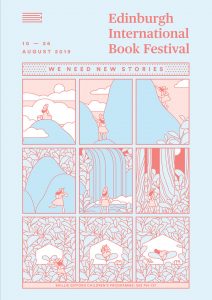 It’s always a thrill when a favourite author revisits a favourite character and weaves a new story for us to delight in. As the theme of the Edinburgh International Book festival 2019 is “we need new stories” this seems a perfect reason to invite novelist Kate Atkinson to its main theatre in conversation with Lee Randall. Atkinson is cool and composed, engaging in conversation but fairly guarded. Like her books, she appears at this event to be measured, thoughtful and never verbose. Talk quickly turns to her arguably most famous character, Jackson Brodie. Randall asks simply why she has written a new Brodie novel, the recently released “Big Sky”.
It’s always a thrill when a favourite author revisits a favourite character and weaves a new story for us to delight in. As the theme of the Edinburgh International Book festival 2019 is “we need new stories” this seems a perfect reason to invite novelist Kate Atkinson to its main theatre in conversation with Lee Randall. Atkinson is cool and composed, engaging in conversation but fairly guarded. Like her books, she appears at this event to be measured, thoughtful and never verbose. Talk quickly turns to her arguably most famous character, Jackson Brodie. Randall asks simply why she has written a new Brodie novel, the recently released “Big Sky”.
Atkinson replies in a coolly unsentimental way “He is a useful thread and structure. He is a way of manipulating a plot.”
Randall admits to thinking of Brodie as a Labrador dog of a man due to his recurrent heroism and his ability to put himself in danger to aid another.“I think of him of less than a Labrador, more of a German Shepherd.” Atkinson corrects her. “It’s very instinctive in him, this instinct to pull you out of the burning building.”
The chat turns to the difference between books and television as her Jackson Brodie books have famously been turned into television series ‘Case Histories’. Randall comments on the difference in complexity in the differing media. “You can’t go inside his head in television. There’s a paucity of language in television.” For many, Jackson Brodie will forever have the handsome face of actor Jason Isaacs, but not for Atkinson. “I live mainly inside his head, so I really don’t have an image of what he looks like.”
Atkinson gives a reading from her book, and the discussion turns to its location.” I wanted to set something on the East coast of Yorkshire.” she explains. “It’s quite a filmic, visual book. Its set somewhere between Scarborough and Whitby. There is a decline in these seaside towns, but here is also an extreme vibrancy.” The discussion moves from setting to character.
It seems to be her female characters Atkinson has most affection for. Randall confesses her affection for the character of Crystal, saying “I like all these bad-ass women.” Atkinson agrees. “Crystal had a terrible childhood and has clawed her way out of it. She has false nails, false hair and yet is a heroic, Amazonian character. Her ferocity comes form her desire to protect her children. She is ruthless.” Atkinson has a knack of drawing characters with many layers of complexity. All have flaws and most have at least some redeeming features so that, as in life, virtually none are “all good or all bad”. This means that her characters all have at least some relatable traits, making for an engaging read. Her books all have some conflict, some duality, and are never predictable.
The discussion turns to the creative power of boredom. Atkinson explains that as an only child in a rural location, she was often alone and imaginative play took up a large and important part of her childhood, paving the way for creativity later in life. “You need to use your imagination”. She remembers “I spent a lot of time on my own, and children these days don’t have that. There’s no space to do nothing.” This, she feels, is not a positive change. “Doing nothing is an important part of the creative process. You are taking things in all the time, and they end up in books in many guises.”
Unfortunately, a thunderstorm of biblical proportions interrupts the event, the very real danger of lightning strike means the fascinating discussion is ended somewhat abruptly. Never a dull moment with Kate Atkinson around.
